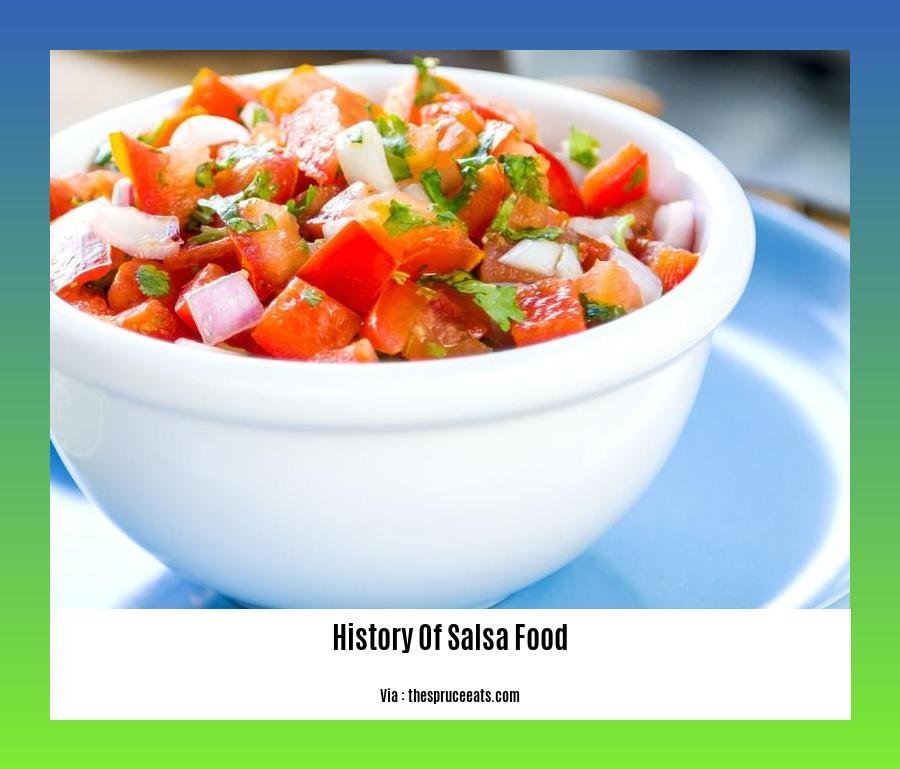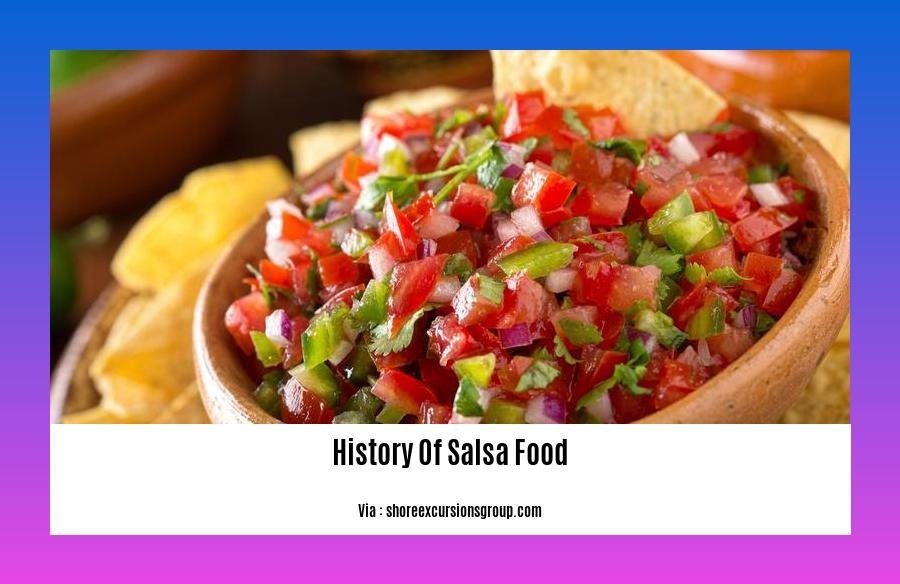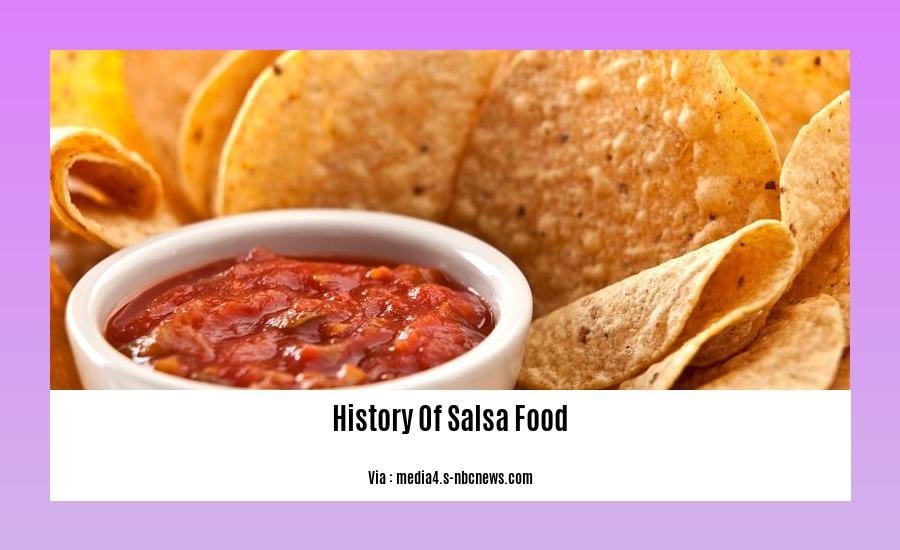Embark on a culinary adventure through time as we delve into “A Culinary Journey Through Time: The History of Salsa Food.” Salsa, a vibrant and versatile condiment, has captivated taste buds worldwide with its tantalizing flavors and rich history. Join us as we trace the evolution of this culinary masterpiece, from its humble origins in ancient Mesoamerica to its current status as a global culinary icon.
Key Takeaways:
-
Salsa’s origins can be traced back to the Aztecs and Mayans of pre-Columbian Mexico, who combined tomatoes, chilies, and other ingredients to create flavorful sauces.
-
The earliest form of salsa is believed to be salsa verde, a green sauce made with tomatillos, green chilies, and herbs, which is still popular today.
-
In the 16th century, Spanish conquistadors introduced new ingredients like tomatoes and onions to Mexico, leading to the creation of new types of salsas including the classic tomato-based salsa roja.
-
Salsa’s popularity in the United States surged in the 20th century thanks to the growing Mexican-American population and the rise of Mexican restaurants.
-
By 1992, salsas outsold tomato ketchup in the U.S., and salsa has become an integral part of Latin American and Mexican cuisine, as well as gaining popularity worldwide.
History of Salsa Food

Have you ever wondered about the origins of salsa, that ubiquitous condiment that adds a burst of flavor to our tacos, enchiladas, and tortilla chips? Join me on a culinary journey through time as we explore the history of salsa food.
From Humble Beginnings
Salsa’s roots can be traced back to the ancient civilizations of Mesoamerica, where the Aztecs and Mayans crafted flavorful sauces using tomatoes, chilies, and other indigenous ingredients. These early salsas, often referred to as “molli,” were essential condiments in their cuisine, adding depth and spice to their dishes.
The Arrival of the Spanish
The arrival of the Spanish conquistadors in the 16th century marked a turning point in the evolution of salsa. They introduced new ingredients like tomatoes, onions, and garlic to the Americas, which were eagerly incorporated into local cuisine. This led to the creation of new and diverse types of salsas, including the now-iconic tomato-based salsa roja.
Salsa’s Rise to Popularity
In the 20th century, salsa’s popularity soared in the United States, thanks in large part to the growing Mexican-American population and the rise of Mexican restaurants. Salsa’s versatility and deliciousness quickly won over American palates, and it soon became a staple in kitchens and restaurants across the country.
A Global Culinary Sensation
Today, salsa has become a global culinary sensation, enjoyed in homes and restaurants worldwide. It has inspired countless variations and innovations, from classic red salsas to spicy green salsas, smoky chipotle salsas, and refreshing salsas frescas.
The Essence of Salsa
The essence of salsa lies in its ability to transform ordinary dishes into extraordinary culinary experiences. Whether it’s adding a kick to tacos, enhancing the flavor of enchiladas, or simply enjoyed as a dip with tortilla chips, salsa brings people together and creates lasting memories.
So next time you savor the taste of salsa, take a moment to appreciate its rich history and the diverse cultures that have shaped its evolution. Salsa is more than just a condiment; it’s a culinary treasure that embodies the spirit of exploration, innovation, and the joy of sharing delicious food.
-
Dive into the captivating history of quesadillas, a culinary masterpiece that has tantalized taste buds for centuries. Journey back in time to uncover the intriguing origins of this delectable dish. history of quesadillas
-
Embark on a culinary journey through the ages to explore the fascinating history of salsa dip, a beloved condiment that has added zest and flavor to our favorite dishes for generations. history of salsa dip
-
Delve into the rich history of salsa sauce, a cornerstone of Mexican cuisine that has tantalized taste buds with its vibrant flavors and versatility. Uncover the captivating tales behind its creation and evolution. history of salsa sauce
Salsa as a Culinary Staple: Tracing the widespread adoption of salsa as a beloved condiment and ingredient in cuisines worldwide, from Mexico to the United States and beyond.

From humble origins in ancient Mesoamerica to becoming a global culinary sensation, salsa’s journey is a tale of flavors, cultures, and culinary evolution. Let’s dive into the fascinating story of how this versatile condiment conquered hearts and taste buds around the world.
Key Takeaways:
-
Salsa originated in Mesoamerican civilizations, where it was crafted from indigenous ingredients like chilies, tomatoes, and herbs.
-
The Spanish conquest brought new ingredients like tomatoes and onions, leading to the creation of diverse salsa variations.
-
In the 20th century, salsa gained immense popularity in the United States due to the growing Mexican-American population and the rise of Mexican restaurants.
-
Today, salsa is a beloved condiment and ingredient worldwide, inspiring countless variations and innovations.
Ancient Roots:
Salsa’s history can be traced back to the ancient civilizations of Mesoamerica, including the Aztecs, Mayans, and Incas. Using ingredients native to the region, such as tomatoes, chilies, and herbs, they created flavorful sauces to complement their cuisine. These early salsas were not only condiments but also essential ingredients in various dishes, adding a burst of flavor and nutrition.
Spanish Influence:
The arrival of the Spanish in the 16th century marked a significant turning point in the evolution of salsa. They introduced new ingredients to the region, including tomatoes, onions, and garlic. This fusion of flavors led to the creation of new salsa variations, including the now-famous tomato-based salsa roja.
Salsa’s Rise in the United States:
In the 20th century, salsa’s popularity soared in the United States. The growing Mexican-American population played a crucial role in introducing salsa to American tables. As Mexican restaurants gained popularity, salsa became an essential condiment, capturing the hearts of diners with its vibrant flavors and versatility.
A Global Culinary Star:
Salsa’s popularity quickly spread beyond the United States, becoming a global culinary sensation. Today, it is enjoyed in countries worldwide and has inspired countless variations and innovations. From classic red salsas to spicy green salsas, smoky chipotle salsas, and refreshing salsas frescas, the world of salsa is diverse and ever-evolving.
Salsa’s success lies in its ability to transform ordinary dishes into culinary delights. Whether it’s tacos, burritos, nachos, or enchiladas, salsa adds a layer of flavor and excitement that makes these dishes irresistible. It’s a condiment that brings people together, creating lasting memories around the table.
So, next time you indulge in a delicious salsa, remember its rich history and the culinary journey it has undertaken to become a beloved staple in kitchens worldwide. Salsa is more than just a condiment; it’s a culinary treasure that embodies the spirit of exploration, innovation, and the joy of sharing delicious food.
Citations:
Salsa (food)
The Ancient Origins Of Salsa
Regional Variations: Highlighting the Diverse Regional Styles of Salsa Across Mexico and Other Parts of Latin America, Showcasing the Unique Flavors and Ingredients Used in Each Region.
Have you ever wondered why your favorite salsa tastes different when you travel to a new region? Salsa, that piquant and versatile condiment that graces our tables, is not just a homogeneous entity; it’s a tapestry of flavors, reflecting the diverse culinary traditions of Mexico and Latin America. Join me on a culinary adventure as we explore the fascinating regional variations of this beloved sauce.
Northern Mexico: A Fusion of Flavors
In the northern states of Mexico, such as Chihuahua, Coahuila, and Durango, salsas bear the mark of their proximity to the United States. Influenced by Tex-Mex cuisine, these salsas often incorporate unique ingredients like cumin, oregano, and ground beef, creating a distinctive fusion of flavors.
Central Mexico: The Heart of Salsa Tradition
In the central region, the birthplace of salsa, we find a dazzling array of styles. Salsa roja, the classic red salsa, reigns supreme, crafted from ripe tomatoes, chili peppers, garlic, and onions. Salsa verde, its vibrant green counterpart, showcases tomatillos, green chili peppers, and cilantro. Salsa borracha, a boozy delight, infuses tequila or beer into its piquant blend.
Southern Mexico: A Symphony of Spices
Venturing south, we encounter salsas that reflect the region’s rich indigenous heritage. Salsa negra, a smoky and complex sauce, is made with dried chilies, spices, and nuts. Salsa macha, a fiery condiment, blends chilies, nuts, and seeds into a spicy symphony.
Other Latin American Variations: A World of Flavors
Salsa’s journey extends beyond Mexico’s borders, taking on new dimensions in other Latin American countries. In Peru, salsa criolla, a vibrant blend of tomatoes, onions, lime juice, and cilantro, adds a tangy touch to ceviche and other seafood dishes. In Ecuador, salsa de ají, made with fiery aji peppers, brings a jolt of heat to local cuisine.
Key Takeaways:
-
Salsa’s regional variations reflect the diverse culinary traditions of Mexico and Latin America.
-
Northern Mexico’s salsas incorporate Tex-Mex influences, such as cumin, oregano, and ground beef.
-
Central Mexico is home to classic salsas like salsa roja, salsa verde, and salsa borracha.
-
Southern Mexico’s salsas, such as salsa negra and salsa macha, showcase indigenous flavors and ingredients.
-
Other Latin American countries have their own unique salsa variations, such as salsa criolla in Peru and salsa de ají in Ecuador.
Sources:
Contemporary Trends: Exploring Modern Interpretations of Salsa
In the world of food, innovation knows no bounds, and salsa is no exception. Contemporary trends in salsa-making are pushing the boundaries of flavor and creativity, resulting in a symphony of taste sensations. Let’s embark on a culinary adventure to discover these modern interpretations of the beloved condiment.
Fusion Salsas: A Culinary Symphony
Imagine a salsa that harmonizes the vibrant flavors of Mexico with the spicy heat of Thai chilies. This is the essence of fusion salsa, where culinary traditions from different corners of the globe collide to create a unique and captivating taste experience. Experimentation with ingredients and flavor profiles is key, as chefs and salsa enthusiasts seek to create salsas that are both familiar and excitingly different.
Artisanal and Gourmet Salsas: A Culinary Symphony
Artisanal and gourmet salsas are a testament to the dedication and artistry of small-batch salsa makers. These salsas are handcrafted with carefully selected ingredients, often sourced locally from farmers’ markets or specialty growers. The result is a salsa that is not just a condiment but a culinary masterpiece, showcasing the unique flavors and textures that can be achieved through artisanal production methods.
The Rise of Gourmet Salsa
Along with artisanal salsas, gourmet salsas have also gained popularity among food enthusiasts seeking a truly elevated salsa experience. Gourmet salsas are made with premium ingredients, such as exotic chilies, specialty spices, and fresh herbs, creating complex flavor profiles that are sure to impress even the most discerning palates.
Key Takeaways:
- Fusion salsas blend the vibrant flavors of Mexico with culinary traditions from around the world.
- Artisanal salsas are crafted in small batches using carefully selected ingredients and traditional methods.
- Gourmet salsas feature premium ingredients and complex flavor profiles, catering to discerning palates.
- Salsa’s popularity continues to soar, with new interpretations and flavors emerging all the time.
Sources:
– Salsa Fusion – Exploring Modern Trends and Creative Styles
– Salsa (food)
FAQ
Q1: What are the origins of salsa?
A1: Salsa traces its roots to pre-Columbian Mesoamerica, where indigenous cultures like the Aztecs, Mayans, and Incas created flavorful sauces using tomatoes, chilies, and various herbs.
Q2: How did salsa evolve over time?
A2: With the arrival of the Spanish conquistadors in the 16th century, new ingredients like tomatoes and onions were introduced to Mexico, leading to the creation of new salsa varieties, including the popular tomato-based salsa roja.
Q3: What are some different types of salsa?
A3: Salsa comes in a diverse range, including salsa verde (green salsa made with tomatillos and green chilies), salsa roja (classic tomato-based salsa), salsa taquera (used as a topping for tacos), salsa criolla (a Peruvian salsa with tomatoes, onions, and cilantro), and salsa fresca (fresh salsa made with chopped tomatoes, onions, cilantro, and chilies).
Q4: How did salsa gain popularity in the United States?
A4: Salsa’s popularity in the U.S. surged in the 20th century due to the growing Mexican-American population and the rise of Mexican restaurants. In the 1980s, tomato-based salsas gained widespread popularity, and by 1992, salsas outsold tomato ketchup in the U.S.
Q5: What is the cultural significance of salsa?
A5: Salsa holds immense cultural significance, representing a blend of history, tradition, and regional pride in Latin American and Mexican cuisine. Its popularity has spread globally, becoming a staple condiment in many cuisines, adding a burst of flavor and zest to various dishes.
















